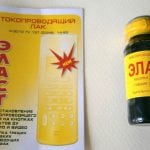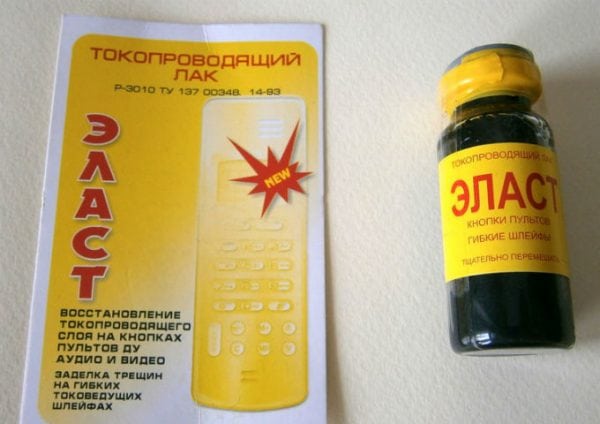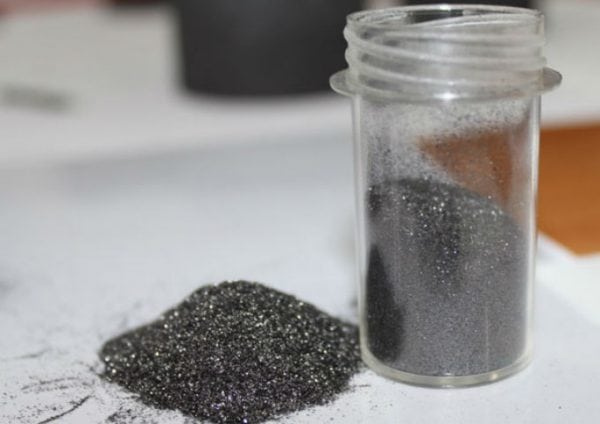A special conductive varnish is designed to restore and maintain electrical conductivity. It is mainly used for repairing conductors and contact groups of remote controls for electronics, household appliances, conductors and tracks of printed circuit boards for various purposes, heating strands for auto glass and other small electrical systems.
The composition of this special varnish is based on special fine-grained components, after polymerization of which, a strong matte film with good electrical conductivity is formed on the surface. The restoration of electrical conductivity occurs literally 60 minutes after varnishing. In the next 10 hours, the result only improves to the maximum. To enhance the effect, you can re-process.
Since the cultivated area is usually negligible, a small amount of substance will be required to work. Therefore, conductive varnishes are sold in small sealed tubes and bottles.
Also found in spray cans - spray - made on the basis of graphite powder. It is used to create conductive surfaces on plastic, glass, metal, wood. It can be used as a lubricant to form a smooth, temperature-resistant, dry-sliding surface.
Before work, the container with the varnish should be shaken well. The solution should be applied accurately, accurately, quickly, with a thin layer. Before surface treatment, it is advisable to clean from dust and dirt, dry, degrease. After operation, the valve (if it is a spray) needs to be cleaned, tightly close the cover.
Caution: the substance has a certain degree of toxicity and is flammable, so be sure to adhere to elementary fire safety rules, work with reagents in a well-ventilated area.
If you want to make graphite varnish with high electrical conductivity, you can do it yourself.
to contents ↑DIY conductive product
Craftsmen offer several recipes for mixing at home such a solution. The main components of the mixture are graphite and silver powder, the difference is solvents and binders. Prepared according to one of the following recipes, varnish (glue) will help solve everyday problems with the electrical conductivity of devices.
Recipe number 1
Ingredients:
- fine powder graphite - 15 g;
- powder silver - 30 g;
- vinyl chloride-vinyl acetate copolymer - 30 g;
- pure acetone - 32 g.
We reduce all components in a mortar and mix thoroughly until a syrupy liquid of gray-black color forms. Pour into a glass container with a tight fitting lid. Before use, be sure to shake (mix). If you use a little less solvent, you can increase the viscosity of the substance. The drying period of the solution after application is at least a quarter of an hour.
to contents ↑Recipe number 2
Ingredients:
- powder graphite - 6 g;
- powder silver - 60 g.
Two options are available as binders:
- Nitrocellulose - 4 g; rosin - 2.5 g; ethyl acetate (acetone) - 30 g.
- Natural shellac - 3 g; ethyl alcohol denatured alcohol - 31 g.
First, mix the powders in a mortar, then add binders. We bring everything to a homogeneous pasty consistency. We shift to a storage container. Stir well before use, if you need to lower the viscosity, use a solvent.
to contents ↑
Recipe number 3
Depending on the mechanical loads of the electrically conductive compounds, various improvised means can be used. For example, get graphite from any finger-type battery and mix with zaponlak. True, this tool has poor adhesion with rubber, so it is better not to apply it to the keys on the control panel. But for the restoration of graphite tracks on the consoles - please.
Recipe number 4
You can quickly make a graphite conductive solution from improvised materials. True, it will not be completely varnish, but the mixture will receive conductive properties. Buy the most common superglue and simple 2M or 4M pencils. Using a file, sharpen the pencil lead in a volume equal to the volume of the tube with glue.
An untouched tube with glue is carefully deployed from the soldering side of the case. Pour the slate powder, and mix thoroughly with a toothpick until a homogeneous mass is obtained.
"Pack" the tube back. In the future, we use the tool, as usual superglue (through the hole with the nozzle).
If your knowledge of electronics is small, and there were problems with chemistry at school, do not rush to prove yourself in the repair of household appliances. It is better to take it to the workshop, where a specialist will find out the causes of the breakdown. Including check, and if necessary correct, the conductivity of the contacts.







